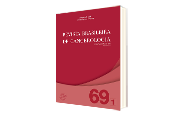Sacral Chordoma: Report of a Rare Malignant Neoplasm
DOI:
https://doi.org/10.32635/2176-9745.RBC.2023v69n1.3519Keywords:
bone neoplasms, chordoma, sacrococcygeal region, case reportsAbstract
Introduction: Chordoma is a type of sarcoma, a primary bone malignancy that originates from the notochord and is located on the spinal axis between the clivus and the sacrum. The first description of this pathology occurred in 1857. Patients between 40 and 60 years old are the most affected according to the disease’s epidemiology, the main site involved is the sacral/coccygeal region. The clinical condition is variable depending on the site affected, with generally nonspecific symptoms, delaying the diagnosis made by biopsy. Among the treatment options, surgical resection with margins is currently the main method, and may be associated with radiotherapy or radiosurgery when necessary; the most common metastatic sites are lungs, bones, liver and local lymph nodes. Case report: A 62-year-old female patient had pain in the coccygeal region, worsening while sitting and the appearance of a nodular lesion with progressive growth, diagnosed as a chordoma three years later, after biopsy of the lesion. Due to the extensive lesion, initially she was submitted to chemotherapy and radiotherapy for cytoreduction, but because of the poor response, she was successfully submitted to sacralectomy, however, dehiscence of the surgical wound was detected, and the patient underwent a new approach; since then, no recurrence in the clinical follow-up. Conclusion: Apparently, it is clear the necessity for further investigations on chordoma, a rare tumor with poor response to non-surgical treatments, in order to improve the chemotherapy for this potentially deforming neoplasm.
Downloads
References
Tenny S, Varacallo M. Chordoma. In: StatPearls. Treasure Island (FL): StatPearls Publishing; 2022.
Williams BJ, Raper DM, Godbout E, et al. Diagnosis and treatment of chordoma. J Natl Compr Canc Netw. 2013;11(6):726-31. doi: https://doi.org/10.6004/jnccn.2013.0089 DOI: https://doi.org/10.6004/jnccn.2013.0089
Atalar H, Selek H, Yildiz Y, et al. Management of sacrococcygeal chordomas. Int Orthop. 2006;30(6):514-8. doi: https://doi.org/10.1007/s00264-006-0095-x DOI: https://doi.org/10.1007/s00264-006-0095-x
Aguiar Junior S, Andrade WP, Baiocchi G, et al. Natural history and surgical treatment of chordoma: a retrospective cohort study. São Paulo Med J. 2014;132(5):297-302. doi: https://doi.org/10.1590/1516-3180.2014.1325628 DOI: https://doi.org/10.1590/1516-3180.2014.1325628
Hindi N, Casali PG, Morosi C, et al. Imatinib in advanced chordoma: a retrospective case series analysis. Eur J Cancer. 2015;51(17):2609-14. doi: https://doi.org/10.1016/j.ejca.2015.07.038 DOI: https://doi.org/10.1016/j.ejca.2015.07.038
Scheipl S, Igrec J, Leithner A, et al. [Chordoma: is there a molecular basis for diagnosis and treatment?] Pathologe. 2020;41(2):153-62. German. doi: https://doi.org/10.1007/s00292-020-00761-4 DOI: https://doi.org/10.1007/s00292-020-00761-4
Sciubba DM, Chi JH, Rhines LD, et al. Chordoma of the spinal column. Neurosurg Clin N Am. 2008;19(1):5-15. doi: https://doi.org/10.1016/j.nec.2007.09.006 DOI: https://doi.org/10.1016/j.nec.2007.09.006
Frezza AN, Botta L, Trama A, et al. Chordoma: uptade on disease, epidemiology, biology and medical therapies. Curr Opin Oncol. 2019;31(2):114-20. doi: https://doi.org/10.1097/CCO.0000000000000502 DOI: https://doi.org/10.1097/CCO.0000000000000502
Conselho Nacional de Saúde (BR). Resolução nº 466, de 12 de dezembro de 2012. Aprova as diretrizes e normas regulamentadoras de pesquisas envolvendo seres humanos. Diário Oficial da União, Brasília, DF. 2013 jun 13; Seção 1:59.
García-Ortega DY, Clara-Altamirano MA, Gómez-Pedraza A, et al. Tumores primarios de sacro: análisis de resultados y complicaciones. Acta ortop. Mex. 2018;32(6):354-7. doi: https://doi.org/10.35366/85433 DOI: https://doi.org/10.35366/85433
Published
How to Cite
Issue
Section
License
Os direitos morais e intelectuais dos artigos pertencem aos respectivos autores, que concedem à RBC o direito de publicação.

This work is licensed under a Creative Commons Attribution 4.0 International License.









